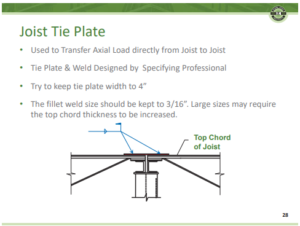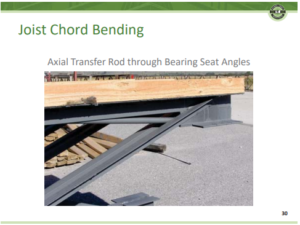Detailing for Diaphragm Chord Forces in Joist and Joist Girders
Joists and joist girders can efficiently transfer diaphragm chord forces to shear walls and lateral frames, but the specifying professional must give due consideration to the connection details. Transferring forces through the joists can induce eccentricities at the bearing seat which can lead to unintended moments on the bearing seat. Have you considered the most efficient way to detail the bearing seat connection when transferring chord forces?
In the November 2023 SEU session, Darrell Marchell, PE, from Vulcraft, and Tim Holtermann, PE, SE, from Canam Steel, on behalf of the Steel Joist Institute, presented Lateral Load Resisting Frames for Steel Joist and Joist Girders. Darrell and Tim identified how open web steel joists and joist girders can be used in different lateral load resisting systems. They explained how to effectively specify loads on the contract documents, shared commonly used connection details, and advised ways to reduce manufacturing and construction costs for different systems.
Tim offered several tips for efficient connections that transfer the diaphragm chord forces without compromising the joist bearing seat. One option, shown in the slide below, is a joist tie plate running across the top of the joists at the location of bearing. SJI recommends the plate width be limited to 4 inches so as to leave room for a downhand weld to the joist top chord and to limit the weld size to 3/16 inch to prevent having to increase the top chord thickness to accommodate a larger weld.

An alternative option could be to use joist tie angles which run on the underside of the top chord. This detail eliminates any interruption or bumps in the steel decking, however an increased seat depth may be required to accommodate the tie angles, as shown in the connection detail below. SJI recommends using 3/16 inch welds for joists and ¼ inch welds for joist girders with longer welds, as needed.
For an exterior location, where the chord forces may create an end moment due to the eccentricity at the bearing seat, an axial transfer rod, as shown below, can be used to transfer the chord force directly from the top chord to the bearing seat. Also, two axial transfer rods can be added to each side of the joist or joist girder if needed to transfer this axial force.
Darrell and Tim noted the joist top chord contributes the most to the expense of the truss, so the specifying professional should heed these recommendations to avoid any unnecessary cost increases in the truss due to inefficient connection details. Diaphragm chord forces can induce significant moments, so specifying professionals need to indicate how they intend to transfer these forces appropriately.




There are no comments yet, but you can be the first